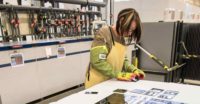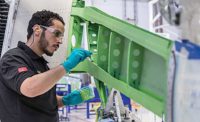
Solar cells and panels require some unique and highly technical manufacturing processes that have more in common with making microchips than mechanical assemblies. And yet, these engineering wonders also share an assembly process with more pedestrian products, like air filters and oil pans.
That process is dispensing. Whether it’s needed for flux, solder paste, dopant, adhesive, ink, potting compound or gasketing material, dispensing technology plays a vital role in the assembly of solar cells and panels. Dispensing equipment is employed at virtually every step in the process, from the very start, when wafers are sliced from a silicon ingot, to the very end, when finished solar panels are assembled into frames.
And that’s just for crystalline and polycrystalline solar cells. Dispensing technology plays a role in manufacturing amorphous or thin-film solar cells, too. In addition, dispensing technology is used to assemble a host of products related to solar power generation, including batteries, inverters and transformers.

Front-End Processes
At the beginning of the process, wafers for solar cells are rapidly and precisely sliced out of silicon ingots with a wire saw. To ensure reliable processing, the entire ingot is bonded to a glass plate and the workpiece holder with a fast-curing, two-component, water-soluble epoxy. Available from Henkel Corp. and other suppliers, the epoxy is dispensed by a robot equipped with a standard valve and static mixer.
After slicing, the edges of the wafer are still fixed to the glass plate. A bath in hot water frees the wafer from the glass without leaving residues behind.
Once photovoltaic circuits have been etched into the wafer, a conductive grid must be superimposed on the surface to collect the electrons produced when light strikes the cell. Traditionally, solar cell manufacturers have created this grid using conductive ink applied with a screen printer. However, as wafers get thinner and more fragile, screen printing is becoming less viable. Instead, some manufacturers are creating the grid by dispensing a network of thin lines of conductive ink. The lines could be less than 100 microns wide.
“You want to make those lines as narrow as possible, because you don’t want to take up light-gathering real estate,” says Terry Dunbar, global key account manager at Nordson Corp. “At the same time, you want the lines to have a high aspect ratio for low resistance.”
Another front-end process that requires dispensing technology is doping. Impurities, called dopants, are applied to the silicon wafer with a spray valve. In a solar cell, two differently doped silicon wafers are sandwiched together to create the one-way flow of electrons necessary to produce electricity. One wafer is doped with phosphorus; the other with boron.

Connecting Cells
To create a solar panel, individual solar cells are linked together in a process called tabbing or stringing. In this process, cells are electrically connected with a solder-coated copper ribbon. Before the ribbon is soldered in place with a heated tool, an alcohol-based flux is applied with a precision spray valve. Thick or tacky fluxes are dispensed with a piezoelectric jetting valve.
“Traditionally, manufacturers pulled the ribbon through a flux bath and then removed the excess,” explains Dunbar. “The problem with that is you can apply too much flux, which can run off the cell and get into the back sheet, creating discoloration.”
Not all manufacturers use a heated tool to solder the ribbon. To avoid the risk of stress fractures from the concentrated heat, some manufacturers apply solder paste to the ribbon and reflow it.
“We dispense the solder paste with an augur valve, because it can achieve a much higher process capability than a syringe-based system,” says Dunbar. “Some people will dispense a bead of paste. Others will just dispense dots, to save material.”
A third option for connecting the ribbon to the cells is an electrically conductive, silver-filled epoxy, which cures at a much lower temperature than needed to reflow solder paste. This option is particularly good for thin wafers, which are more susceptible to thermal shock.
A piezoelectric jetting valve is used to dispense dots of epoxy approximately 1 millimeter in diameter. For jetting applications, “you can’t just grab any conductive adhesive off the shelf,” warns Dunbar. “There are adhesives specifically formulated for jetting. They have less than 70 percent fill, and the plate sizes are smaller so they don’t clog the nozzle orifice.”

At the Junction
The strings connecting the solar cells terminate at the back of the panel in a junction box. Inside the box, the strings are soldered to terminals or inserted into compression fittings. There are three applications for dispensing technology here.
First, a bead of formed-in-place gasketing material is dispensed around the edge of the box. A silicone material, such as Elastosil 1100 from Wacker Chemical Corp. or PV-8030 from Dow Corning Corp., is dispensed with a high-pressure valve fed by a gear pump. The valve is mounted to a Cartesian or six-axis robot.
“They’re not petite beads,” notes Dunbar. “You’re looking at 0.25-inch or even 0.5-inch beads, because you want to make sure there’s a hermetic seal.”
Robots are often used for dispensing adhesives and other materials in solar panel production. A six-axis robot or a gantry robot can be programmed for many different sizes of panel. If you have to apply sealant to a large solar panel, it’s very difficult to reach over and place a bead of material on all four sides.
Diodes are installed inside the junction box to prevent current from flowing backward through the module. These diodes are attached with solder paste dispensed from an augur valve.
Once the junction box has been assembled, some manufacturers will pot the enclosure to protect the electronics from moisture, especially if the panel has a long-term warranty. A two-part silicone encapsulant, such as Elastosil 2202 from Wacker Chemical, is dispensed with a piston pump or gear pump feeding a standard two-component valve and static mixer.
With the junction box in place, the final step in the process is to place the finished panel in a frame, which is typically assembled from glass and aluminum extrusions. A silicone sealant or hot-melt adhesive is dispensed inside the frame and around the glass prior to assembly for added strength and protection against moisture. A few screws are then installed to keep the frame in place.
ASSEMBLY ONLINE
For more information on dispensing, visit www.assemblymag.com to read these articles:
* How to Improve Dispensing Processes and Quality With Robotic Dispensing Technology.
* Better From the Benchtop.
* Dispensing Cyanoacrylates.






